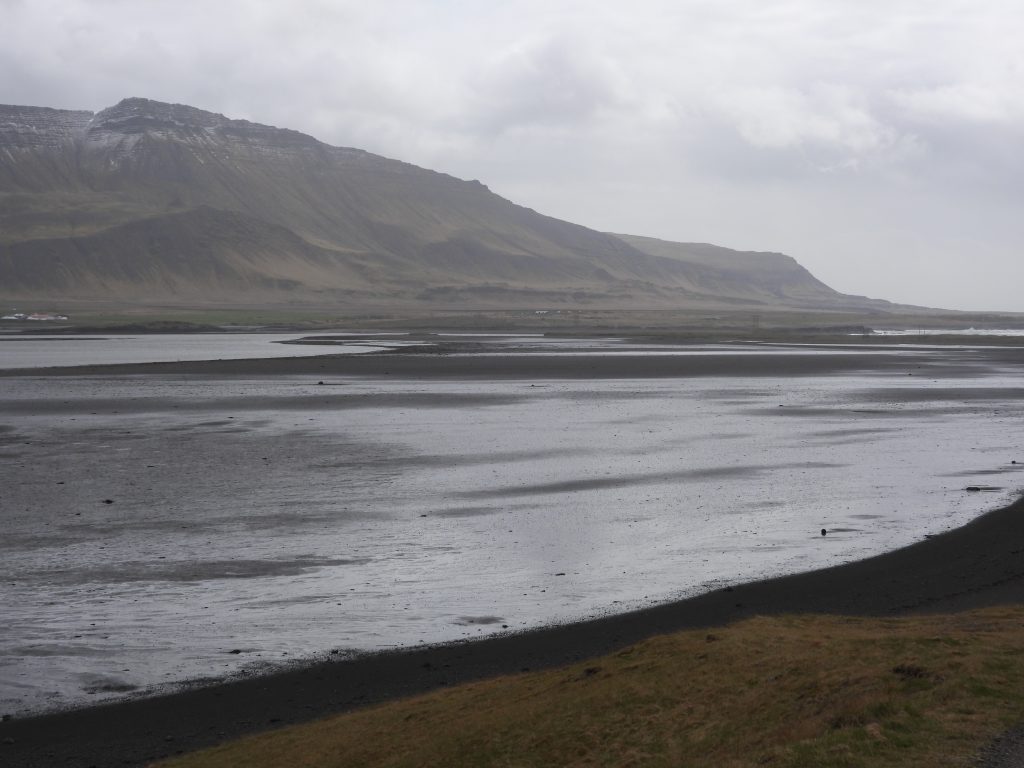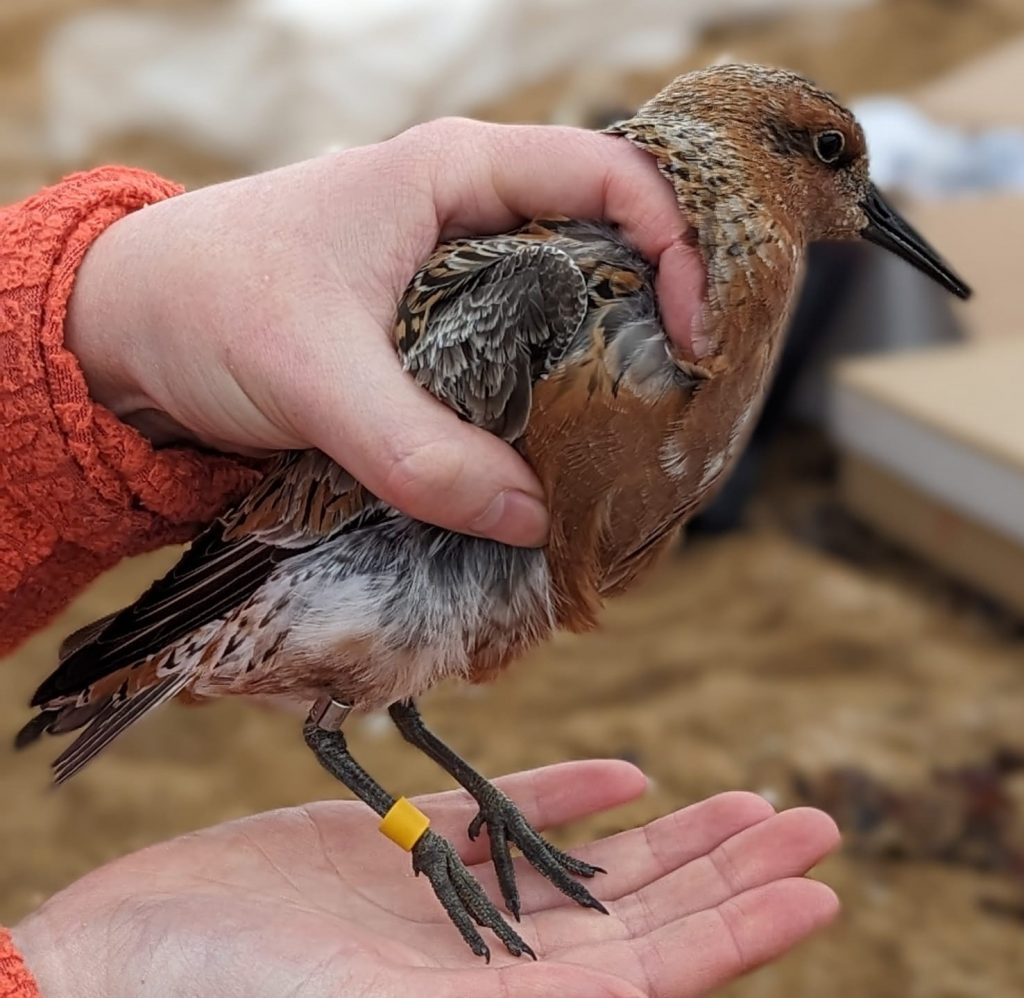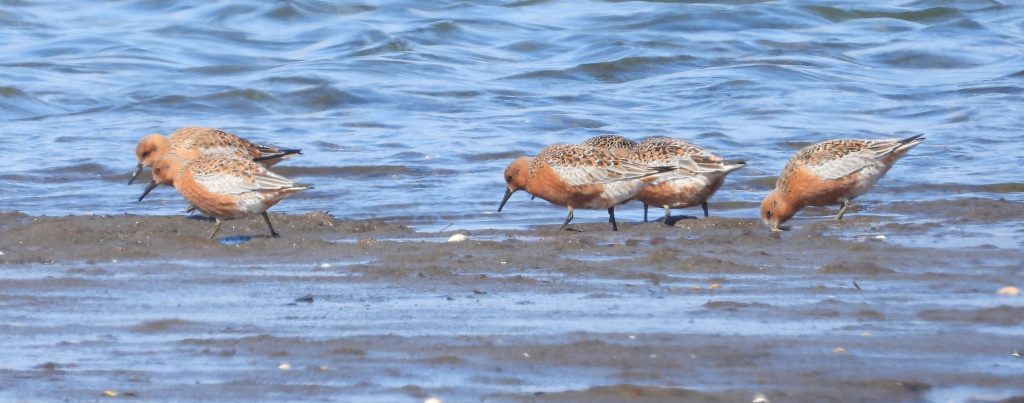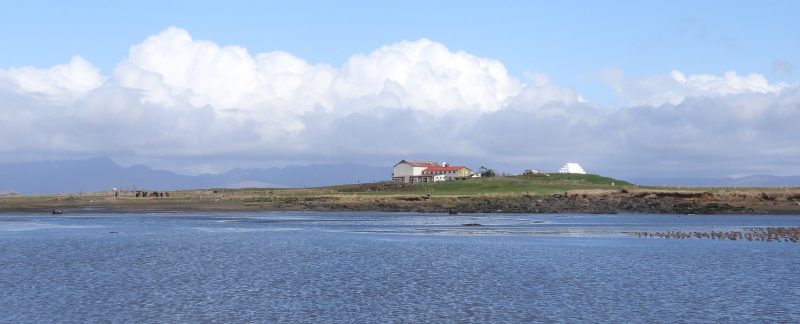Whilst several group members were undertaking fieldwork on Knot ssp rufa staging on migration in Delaware Bay (USA) along the Atlantic Flyway, two group members were part of an international team in Iceland surveying Knot ssp islandica staging on migrationalong the East Atlantic Flyway. The Iceland team comprised Knot enthusiasts from Norway, The Netherlands, Ireland, Scotland, and England, representing several of the countries where Knot have been colour-marked over the last few years.
Although we cannot compete with the longevity of involvement of some of the individuals who have been part of the Delaware Bay project, this was the fourth visit of WWRG members to Iceland since 2019. The two trips undertaken in 2019, (spring and autumn) were primarily to look for Knot that had been colour-marked in Iceland and Norway (WWRG Biennial Report 2018/19). At that time, no Knot had been colour-marked on The Wash. The first Knot were colour-marked on The Wash in autumn 2020 and we have now added 422 birds to the pool of Knot that may be encountered in Iceland and elsewhere along the East Atlantic Flyway. Inevitably, trips to Iceland were cancelled in 2020 and 2021 due to the Covid-19 pandemic but we were able to return to Iceland with the team in 2022.
The leader of our team, Jim Wilson, has been studying Knot in Iceland since the early 1970s and has made many discoveries over the years regarding Knot migration routes including the numbers of Knot staging in Iceland, the timing of arrivals and departures to and from Iceland, the differences in weight between arrival and departure and the departure directions as the Knot leave for the breeding grounds in Greenland and Arctic Canada. Prior to our involvement, Jim took teams to Iceland in May 2011, 2014, 2017 and 2018. In 2005 Jim started studying Knot on migration in Porsangerfjordan, northern Norway, which is also a staging area for Knot ssp islandica in spring. This work has added to the understanding of the two migration routes and suggests that many birds staging in Iceland and Norway probably breed in different areas in Greenland and Arctic Canada.
The team was based at a house just north of Borgarnes in south-west Iceland, close to the main study area of the fjords around Faxaflói, the large bay in west Iceland between the Reykjanes and Snӕfellsnes peninsulas. We also surveyed some of the fjords on the northern coast of the Snӕfellsnes peninsula. In previous years the team has split time between south-west Iceland and north-west Iceland but the plan for 2023 was to concentrate solely on the south-west in order to maximise catching opportunities. This is an important agricultural area of Iceland with increasing amounts of barley grown in addition to the more traditional sheep pasture and cattle rearing. Although not such dramatic scenery as in other parts of Iceland, the views towards the snow-capped mountains and volcanoes are stunning.
Objectives
In addition to resighting colour-marked Knot, an important objective of the trip was to make at least one successful cannon-net catch of Knot on one of the known beach roost sites. This was important as the proportion of Icelandic colour-marked Knot in the population has gradually reduced due to mortality since the last significant catches in Iceland in 2017. It was also important to gather information on the weights of the birds whilst staging in Iceland. Other objectives included counting Knot in the traditional roost sites in the fjords to estimate the numbers of Knot staging at different times throughout May as a comparison with previous years and to monitor departure dates and directions. We were also keen to further investigate the use of newly-sown barley fields a short distance inland from the fjords, which the Knot have been using both as roosting and feeding sites in recent years. There was a tentative plan to catch on the barley fields using a whoosh net should permissions and other factors make this a possibility.
Two members of the team arrived in early May, staying at the Agricultural University, to undertake recces and gain permission from all the landowners for access to their land to resight Knot in preparation for the arrival of the rest of the team. During this time they were able to make a good start on the resighting totals and exploration of the use of barley fields.
Resighting
Good weather during the first two weeks of May provided excellent resighting conditions (despite waking up to a covering of snow one day) but then deteriorated substantially during the remainder of the trip with strong winds, driving rain and hail. Although the weather failed to stop the intrepid team from going out each day, we struggled to read as many flags during this time and our total number of resightings for 2023 was well down on 2022. We received several severe weather warnings from the car hire company due to the high winds. It was wise to have two people opening car doors together as the wind can easily force the door right back off its hinges (the only thing that Platinum Level Insurance does not cover on the hire cars!).
Information on the best tides for resighting at different sites has been built up over the years in much the same way as WWRG has done for The Wash sites. The main areas for resighting are the mudflats in the fjords and the newly-sown barley fields inland from the fjords. Certain fjords can provide good opportunities on either rising or falling tides and some fjords are particularly good at low tide when the Knot feed on mussel scars far out on the mudflats. Of course, it never really gets dark in Iceland in May so the days can be as long as there is energy and the will to resight!

A total of 287 individual Knot were resighted by the team during the trip, many of which were sighted on multiple occasions. Table 1 shows that Knot ringed in the Dutch Waddensee by NIOZ (Royal Netherlands Institute for Sea Research) had most resightings with their combination of four colour-rings and an uncoded flag, followed by the orange-flagged birds from north-west England and north Wales and yellow-flagged birds from south-west Iceland. The NIOZ and Humber colour combinations can be easier to read in windy weather as individually coloured rings and flags are more easily seen than the letters and/or numbers on the coded flags of the other schemes.
However, far the most exciting for us were the lime-flagged Wash birds of which eight individual flags were seen (see Table 2). Another highlight was the encounter of a Knot ringed in Virginia in 2010, subsequently seen in Mispillion Harbor, Delaware in 2014. This individual was probably the one seen at the same location in Iceland in 2022 although the last digit was unclear with the 2022 reading.
There were six resightings of Knot ringed in Norway. These represent the individuals that have switched their staging area on spring migration from Norway to Iceland, something that has been discovered through colour-marking studies (Wilson et al. 2011). One missing piece in the jigsaw is whether the Knot which have switched staging areas also switch breeding area since it is thought that many Norwegian staging Knot breed in different areas from those staging in Iceland.
Table 1: Number of Colour-marked Knot resighted
| Region where colour-marked | Number of individuals resighted |
| The Netherlands | 108 |
| North-west England and North Wales | 74 |
| South-west Iceland | 66 |
| Scotland | 14 |
| The Wash | 8 |
| Norway | 6 |
| Mid Wales | 4 |
| North-west Iceland | 3 |
| Humber | 2 |
| Ireland | 1 |
| USA | 1 |
| Total | 287 |
It was interesting to check our records and discover that nine of the 287 Knot resighted in Iceland have previously been resighted on The Wash: three colour-marked in Iceland, two in The Netherlands and four in the UK.
Table 2: Histories of the WWRG Colour-marked Knot resighted
| Individual (colour-mark) | Status (age) | Date | Location |
| EEC | Ringed (2cy+) | 11/09/2022 | Wrangle Tofts, Lincolnshire |
| Sighted | 08/04/2023 | Formby, Merseyside | |
| Sighted | 07/05/2023 | Grunnafjörður, Iceland | |
| Sighted | 19/05/2023 | Hvalfjarðareyri, Iceland | |
| EKP | Ringed (2cy+) | 11/09/2022 | Wrangle Tofts, Lincolnshire |
| Sighted | 15/02/2023 | North Bull Island, Dublin | |
| Sighted | 08/05/2023 | Akrar, Iceland | |
| Sighted | 09/05/2023 | Akrar, Iceland | |
| HLJ | Ringed (2cy+) | 29/10/2022 | Admiral’s Farm, Terrington |
| Sighted | 10/05/2023 | Skógarnes, Iceland | |
| HNN | Ringed (2cy) | 27/05/2021 | Ainsdale foreshore, Merseyside |
| Controlled | 22/01/2023 | Admirals’ Farm, Terrington | |
| Sighted | 15/05/2023 | Hítarnes, Iceland | |
| HCT | Ringed (1cy) | 07/11/2021 | Heacham North |
| Photo | 20/11/2021 | Heacham North North | |
| Photo | 21/11/2021 | Heacham North North | |
| Sighted | 17/05/2023 | Skógarnes, Iceland | |
| CJN | Ringed (1cy) | 07/11/2021 | Heacham North |
| Photo | 21/11/2021 | Heacham North North | |
| Sighted | 18/05/2023 | Skógarnes, Iceland | |
| HUP | Ringed (1cy) | 07/11/2021 | Heacham North |
| Photo | 16/04/2022 | Criccieth, North Wales | |
| Sighted | 18/05/2023 | Hvalfjarðareyri, Iceland | |
| Sighted | 19/05/2023 | Hvalfjarðareyri, Iceland | |
| HUY | Ringed (1cy) | 07/11/2021 | Heacham North |
| Sighted | 20/05/2023 | Grunnafjörður, Iceland |
Catching
One of the traditional roosting sites is at Skógarnes, towards the northern end of Faxaflói. This site has been used for catching Knot on several occasions in previous years. There was a possibility for a cannon-net catch here during the second week in May coinciding with the spring tides. After an initial, unsuccessful attempt on 16 May where there was just too much wave action for a safe catch, we returned on 17May in calmer conditions for a second try. The Knot were reluctant to come into roost in the vicinity of the net on the rising tide but, just as the tide was about to fall below the catching area, and when most of us had given up hope of catching, some wonderful twinkling orchestrated by Jim and carried out by two members of the team resulted in a sudden instruction to fire and a catch of 304 birds was made.
The catch included five controls, one ringed in Iceland, one in The Netherlands, one in France and two in England. The controls from Iceland and The Netherlands were particularly useful as both had incomplete colour-marks. The Iceland bird had lost its flag leaving only the yellow colour-ring, so was fitted with a new coded flag enabling its life history to continue. The bird from The Netherlands had three remaining colour-rings and had been resighted earlier in the week.

A second cannon net catch was attempted near the whaling station at Hvalfjörður on the last but one evening before most of the team departed. This window of opportunity opened up due to an unexpectedly clear, calm evening after several days of wind and rain. Unfortunately, the wind had calmed so much that that the tide cut more than expected and the birds failed to reach the catching area despite a good effort on twinkling. The wet and windy weather had returned by the following morning so a second attempt at this site was not possible. (As an aside, we were really pleased to learn that the Icelandic government suspended all Fin whaling on 21 June 2023 until the end of August 2023. Hopefully this ban will be extended thereby making the whaling station redundant).
The whoosh net was successfully trialled but unfortunately the barley fields were too wet and muddy to use it safely. As an alternative, one team member devised a walk-in trap and constructed it from locally sourced chicken wire. Despite deploying it in one of the fields where Knot were feeding and patiently waiting all day with a good supply of porridge oats, the Knot refused to enter the trap and be caught.
General notes and thoughts on the trip
In addition to the spectacle of the staging Knot flocks of up to 20,000, Iceland is a great place to see other species of waders in breeding plumage with large numbers of Sanderling and Turnstone arriving mid-May. Sanderling numbers built up in the third week in May and, on our return from resighting Knot on the incoming tide at Akrar, we were treated to a spectacle of summer-plumage Sanderling feeding at the edge of the tide along the length of a sand spit with Red-necked Phalaropes feeding in the water just offshore. Large numbers of Pale-bellied Brent Geese were seen but just a few Greenland White-fronted Geese as these had mostly already passed through. The team resighted several colour-marked Brent Geese as well as two Turnstone, one of which was ringed in Portugal and the other in Rhos-on-Sea, Conwy by SCAN Ringing Group on 19 February 2023. We had great views of Harlequin Duck, a stunning Icelandic speciality, feeding close inshore on Skógarnes beach. Other notable birds included Redwing and Snipe, both of which are numerous breeding birds in this area and which sing all through the night. Black-tailed Godwit, Whimbrel and Ptarmigan were regularly seen as we drove around the area and a couple of White-tailed Eagles passed overhead. Yet again, we missed seeing a Gyr Falcon!
Evening entertainment came in different forms. The Eurovision Song Contest was watched with great amusement by some of the team whilst others remained hidden away in the kitchen inputting data. A far more interesting evening was provided by Jim who, over a glass or two of whisky, gave two fascinating talks from his recent trip to a wader conference in Germany hosted by Peter Prokosch. In the first of these, Jim presented a comprehensive account of the information gained from studies of Knot in Norway and Iceland incorporating information both from resighting of colour-marked Knot and from earlier controls of metal ringed birds. In the second talk, Jim gave a resume of a talk given by William Dick to the conference in Germany on the very first wader studies on the Banc d’Arguin (and grandly named the Oxford and Cambridge Mauritania Expedition) in 1973. This expedition came about as a result of the enthusiasm of a group of young people who met each other as members of WWRG.
Our trip to Iceland in 2023 presented different challenges from Jim’s expeditions in the early 1970s. Other than battling with the weather, the greatest challenges of a modern expedition appear to be the mastering of the electronic controls on virtually everything, whether with the car (the automatic hybrid 4×4 with no battery which the car hire company had no clue about), the mobile phone operated access barrier to the gravel track leading to the house where we stayed, or the house itself with a range of kitchen appliances which almost defeated the cooks. The hot tub challenge was fortunately avoided due to the inclement weather.
We had an enjoyable and productive two weeks in Iceland and considered that 300 newly colour-marked Knot and 287 individual Knot resighted were a good result for our efforts. It was an enthusiastic and hard-working team with everyone bringing their knowledge and experience to ensure that the objectives were largely achieved whilst also having fun.
We are already looking forward to 2024!

References
Grayshon, L., Wallace, J., Clark, J.A. & Ireland, P.L. (2021) Wash Wader Ringing Group 2018–19 Report.
Wilson, J., Benediktsson, G.Ö., Croger, R., Dick, W., Hooper, K., Morrison. G., Potts, P., Swinfen, B. & Swinfen, R. (2011) Red Knots marked in N Norway switch spring migration staging area to Iceland. Wader Study Group Bulletin 118, 175–180.
Thanks to Carole Davis and Bernard Siddle for writing this report. Cover photo by Bernard Siddle.

